More than just a meat substitute, tofu and soy products have been eaten by the Japanese for centuries. Learn about its origins and the different varieties you may encounter in Japan.
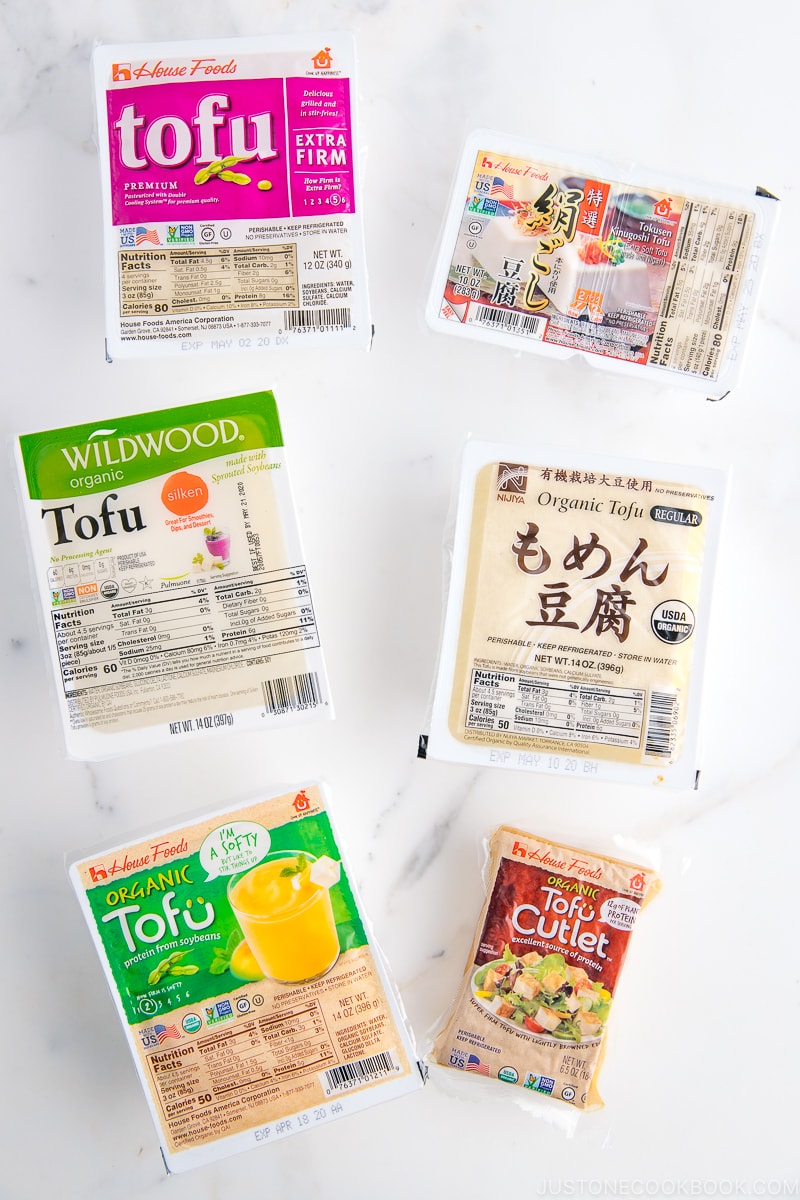
Tofu (豆腐), the jiggly block of bean curd, has been long touted as a superfood. High in protein, gluten-free, low-calorie, low in cholesterol, and versatile in cooking, what’s not to love?
Often described as ‘the meat of the fields’ (畑の肉), tofu and soy foods have been eaten for centuries in many Asian countries. It comes in a wide variety: fresh, frozen, fried, or dried, in blocks, cubes, or tubes! And each can be eaten in all sorts of ways.
It is an essential pantry item and soul food for the Japanese diet. It is appreciated for its flavor, texture, transformative potential, and freshness. If you can get high-quality tofu, you only need a trickle of soy sauce to bring out the delicate, sublime flavor.
So, how much do you know about tofu and its place in Japanese food culture? Let’s get started!
Table of contents
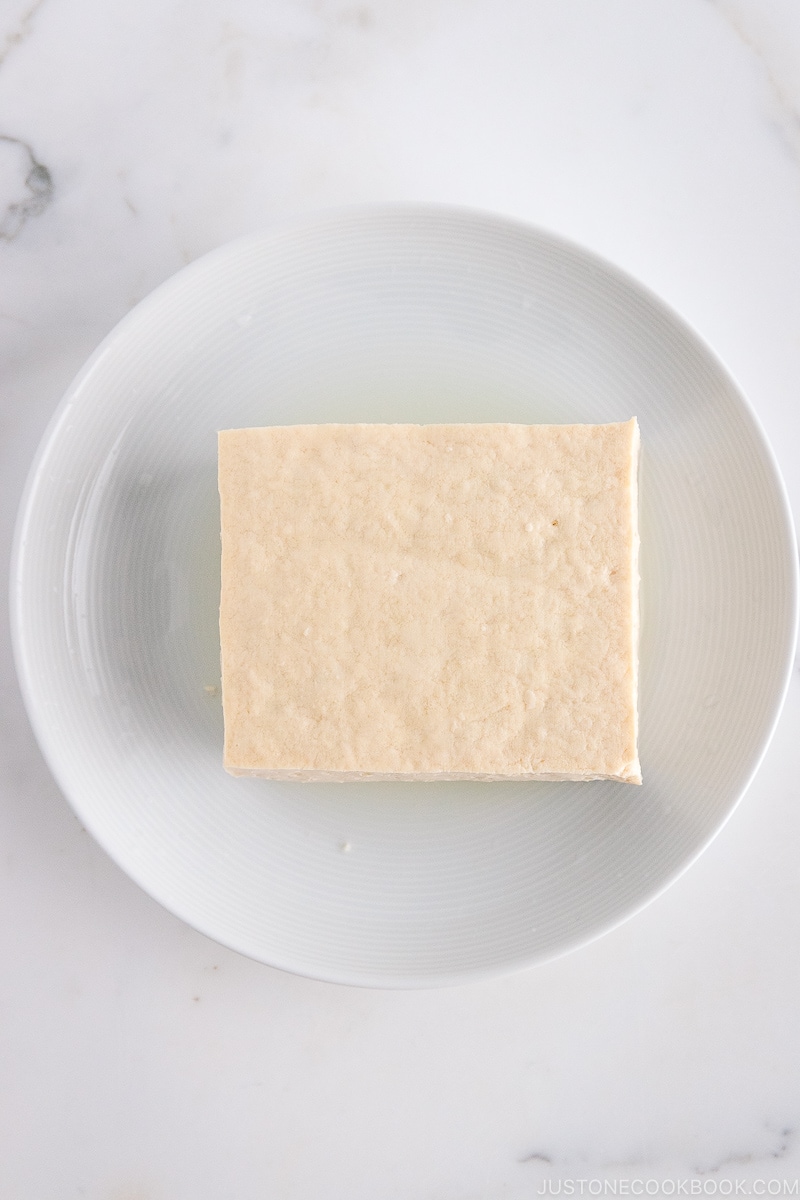
What is Tofu?
There are three ingredients in tofu: soybeans (大豆), water, and nigari (にがり).
Tofu is made with soybeans soaked in water, pureed, then boiled. Once the soy milk and pulp are separated, the soy milk is coagulated by a firming agent, usually nigari (Magnesium chloride, produced from evaporated seawater). It comes in a wide range of textures, depending on how much water is pressed out of the curds.
Most of the tofu found in Japan is made from imported non-GMO soybeans, usually from the U.S. and Canada. The one made with domestic soybeans tends to be a little more expensive. The price ranges from the cheaper mass-produced store brands to small-batch high-quality tofu.
The flavor of fresh tofu is mild with a slightly bean-y taste. The color is white or off-white, depending on the soybeans used (it can also be made from black beans, which make a dark purple to greyish black tofu, and other varieties of colorful soybeans, but this is rare).
Fresh tofu is packed in water. It should be consumed quickly because it does not have a long expiration date. Fried tofu can be frozen for later use.
To see how it is made, check out these videos (how to make tofu at home, a family owned tofu shop in Kagawa prefecture, a tofu shop in Tokyo). For those who are curious, there are lots of DIY videos on YouTube.
What does Tofu mean?
Tofu (豆腐) is composed of the Chinese characters “bean” and “ferment.” But as explained above, there’s no fermenting involved in the process. So, how did the word come to be?
The character 腐 also means “a soft and bouncy mass (colloid),” so the characters would read “a soft and bouncy mass made of beans.” Another origins theory breaks down the Chinese character 腐 into 府 and 肉, 府 means “storage” (among other meanings), and 肉 means “meat,” referring to a storage in ancient China where game meat was hung until tender and soft. The meaning eventually expanded to soft foods other than meat.
Some Japanese producers replace the 腐 with 府 or 富 (wealth, fortune) to avoid the negative connotation of 腐.
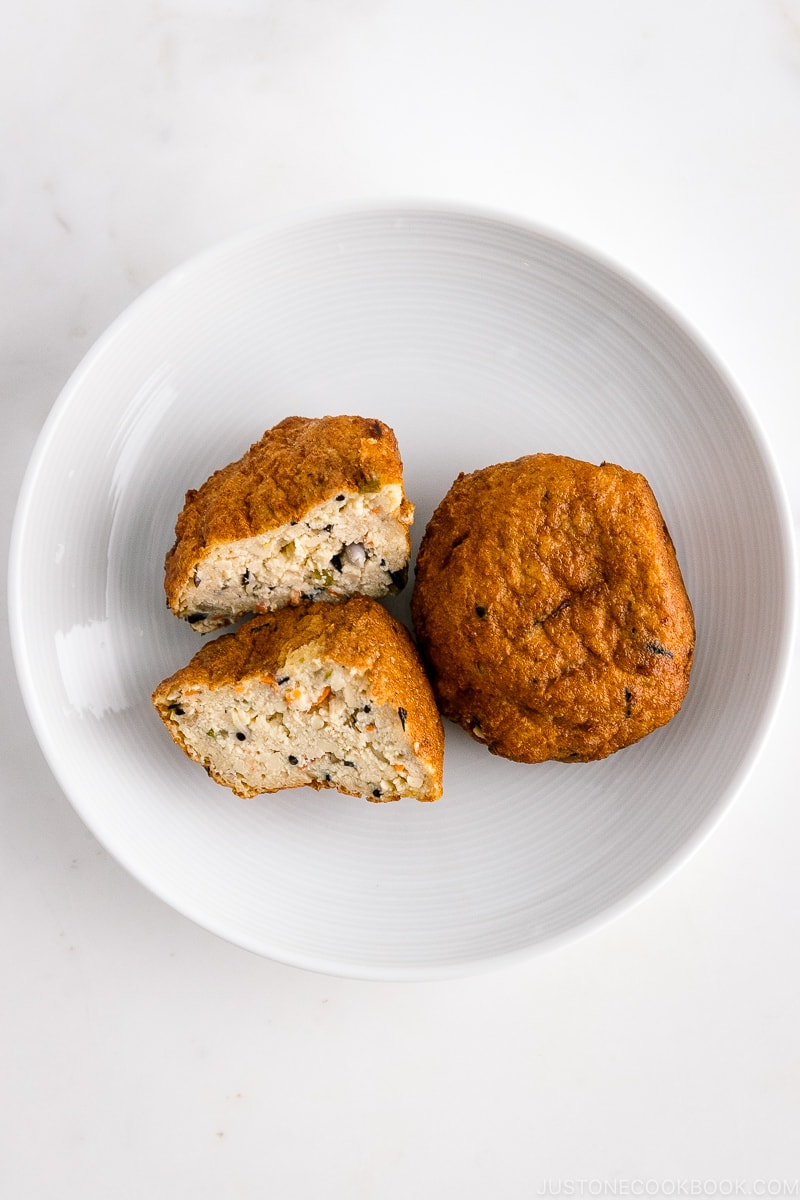
The Health Benefits of Tofu
Let’s take a look at the various nutrients in tofu. While the exact nutritional content varies depending on its processing, the coagulant used, and whether it’s fortified with additional supplements, here’s a rough breakdown.
- Protein: It is rich in protein, making it an excellent alternative to meat for vegetarians and vegans. It contains all nine essential amino acids necessary for human health.
- Calcium: It is a good source of calcium, which is essential for bone health, muscle function, and nerve transmission. It may lower the risk of osteoporosis.
- Iron: It provides iron, a vital component of hemoglobin, the protein in red blood cells that carries oxygen throughout the body.
- Magnesium: It contains magnesium, which is essential for muscle and nerve function, blood sugar control, and bone health.
- Phosphorus: This mineral is essential for bone health, energy metabolism, and the synthesis of DNA.
- Copper: It contains copper, a trace element that plays a role in iron metabolism, the formation of red blood cells, and the maintenance of healthy connective tissues.
- Selenium: It contains selenium, an antioxidant that helps protect cells from damage and supports thyroid function.
- Manganese: It provides manganese, which involves bone formation, blood clotting, and reducing inflammation.
- Zinc: It contains zinc, an essential mineral that supports the immune system, wound healing, and DNA synthesis.
- Vitamins: It is a good source of various vitamins, including B vitamins such as B1 (thiamine), B2 (riboflavin), B3 (niacin), B6 (pyridoxine), and B12 in fortified versions. These vitamins affect energy metabolism, nerve function, and red blood cell formation.
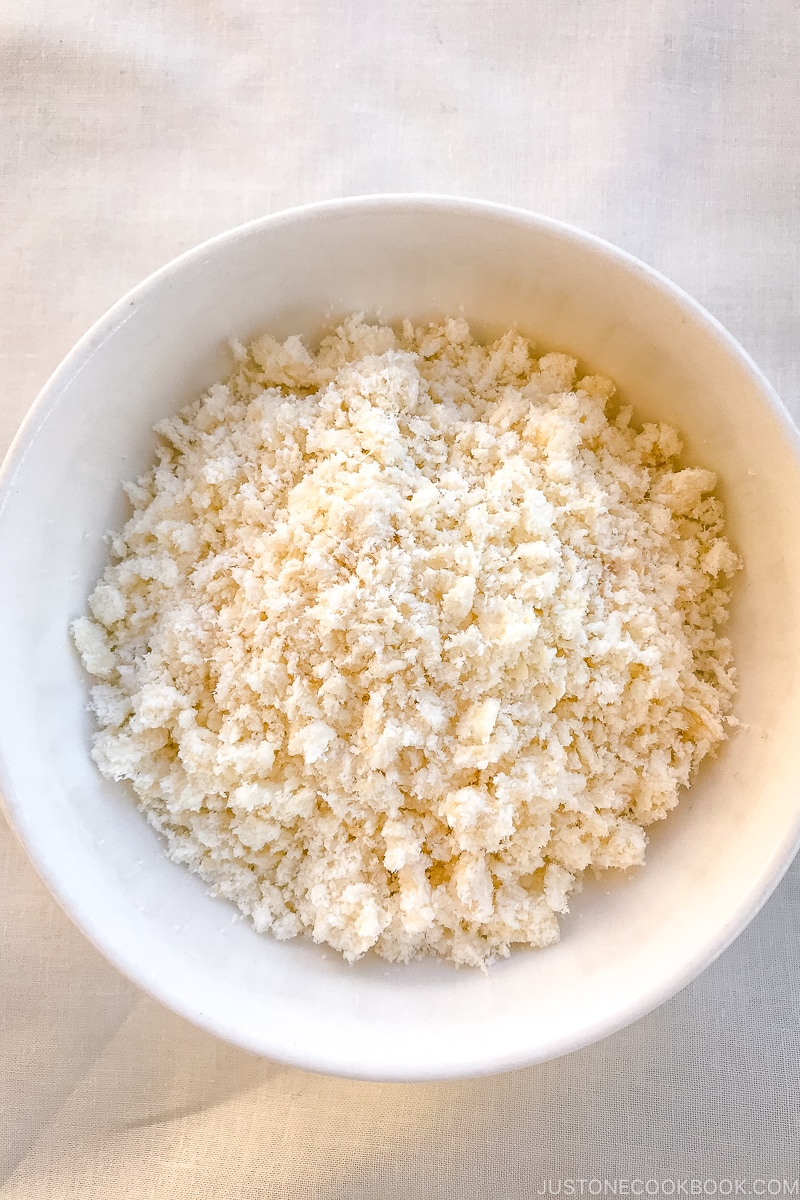
The Origins of Tofu
Tofu originated in China some 2,000 years ago during the Han Dynasty, with several contested theories and speculations of its discovery. Some say it was discovered by Prince Liú Ān (179–122 BC). Others say it was based on the Mongolian techniques of cheese making or just a result of a happy accident. A mural incised on a stone slab may depict the preparation of tofu in the eastern Han Tomb of Henan province, made around 50 AD (although scholars contest whether or not the mural depicts tofu production). The oldest written reference to tofu appears in the poem “Ode to Tofu” by Su Ping in 1500.
It was introduced to Japan during the Nara era (710-794) when scholars and Zen Buddhist monks studying in China brought it back. It became an integral part of Shojin Ryori (精進料理; meatless Buddhist meal) for its high protein content, and its popularity soon spread among the court nobility and samurai class.
The first written record of tofu was in 1183 by the Shinto priest Hiroshige Nakaomi as an offering at the Kasuga Shrine in Nara (the ancient capital of Japan before Kyoto).
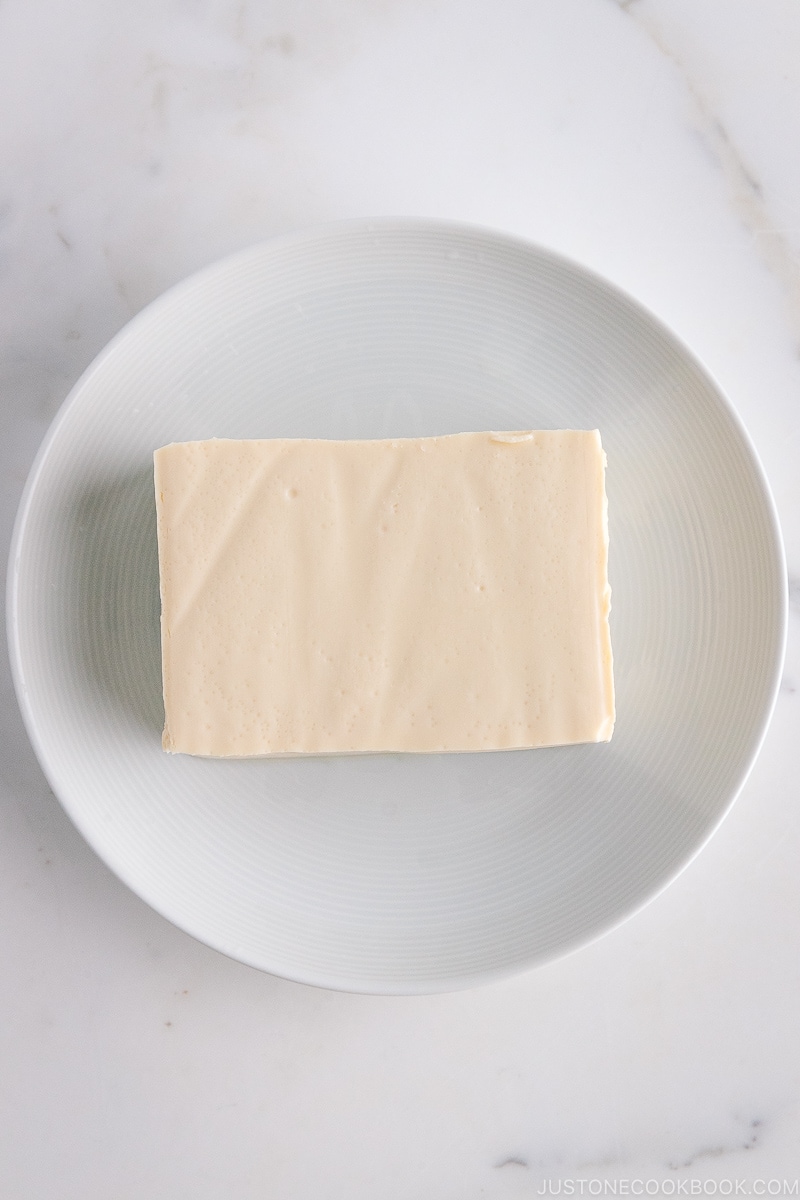
It wasn’t until the Edo era (1603-1867) that the commoners ate it. During the early Edo era, tofu production was heavily regulated, so it was expensive and only for festive occasions. But by the mid-era, tofu shops around Edo (Tokyo), Kyoto, and Osaka popped up. A cookbook dedicated to tofu called Tofu Hyakuchin (豆腐百珍) was the cause of a boom, popularizing it among the commoners. Published in 1782 with over 100 recipes, the cookbook was wildly successful, covering tofu recipes for everyday meals and special occasions.
The popular way of eating tofu by the Edokko (the people of Edo) is said to be grilled on sticks with a smear of red miso, called Dengaku (田楽). The tofu eaten at the time is said to resemble Momen dofu (木綿豆腐; firm tofu, more below).
The tofu restaurant Sasanoyuki (笹の雪) in Negishi, Tokyo, is attributed to bringing Kinu tofu (絹豆腐; silken tofu) to Edo from Kyoto. The 350-year-old restaurant still exists, where diners can feast on elaborate course meals.
The Europeans caught wind of the mysterious cheese-like food as well. The word “tofu” is first mentioned in the Portuguese-Japanese dictionary “Vocabulario da lingoa de Iapan” (1603), compiled by Jesuit missionaries in Nagasaki. The first mention of tofu in English was by Captain John Saris in 1613, who mentioned it in his travel log when he visited Japan. Benjamin Franklin learned about it via letter correspondence in 1770.
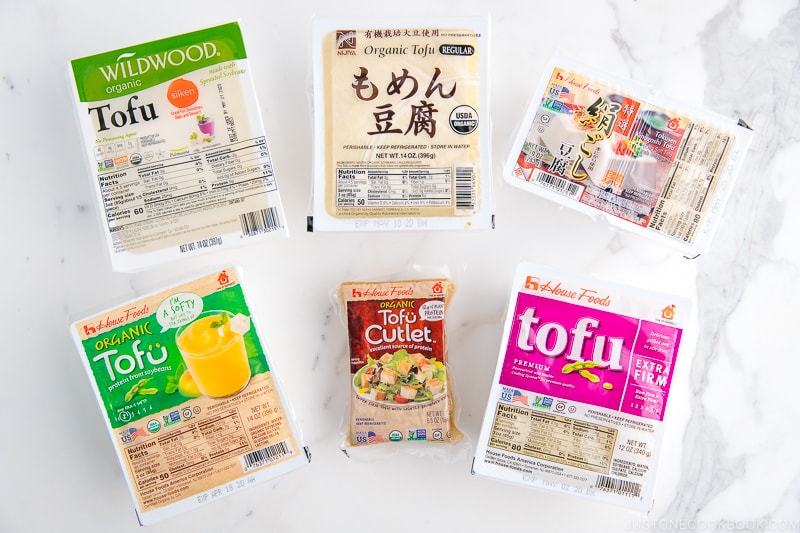
Varieties of Tofu
In general, it can be categorized into three groups:
- Fresh
- Processed
- By-products
There are regional varieties, but we’ll focus on the ones most easily found in supermarkets across Japan. Below are the different types of tofu.
1. Fresh Tofu
- Kinu Tofu/Kinugoshi Tofu
- Momen Tofu
- Yose Tofu/Oboro Tofu/Sukui Tofu/Zaru Tofu
- Jyuten Tofu
Kinu Tofu/Kinugoshi Tofu (絹豆腐・絹ごし豆腐)
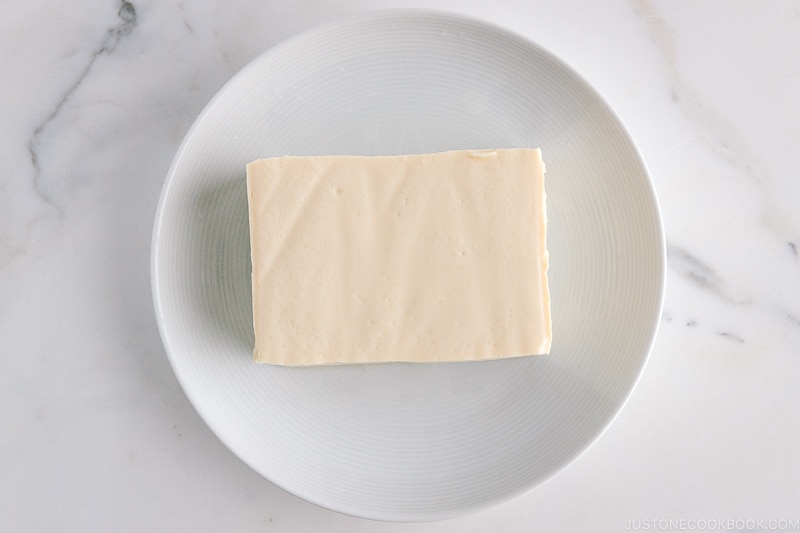
Also known as silken tofu (Kinu (絹) is the Chinese character for “silk”), Kinu tofu is made by mixing soy milk and nigari, then heating the mixture until it hardens. The resulting mass is smooth, custard-like, and crumbles easily, so it is usually eaten as is. It is sold in square or rectangular blocks.
How to use it: Eat chilled or warmed, mashed as a dressing for blanched vegetables called Shiraae, or slip the cubes into a miso soup. It can also be used in desserts such as pudding, donuts, and other baked goods or added to smoothies.
Momen Tofu (木綿豆腐)
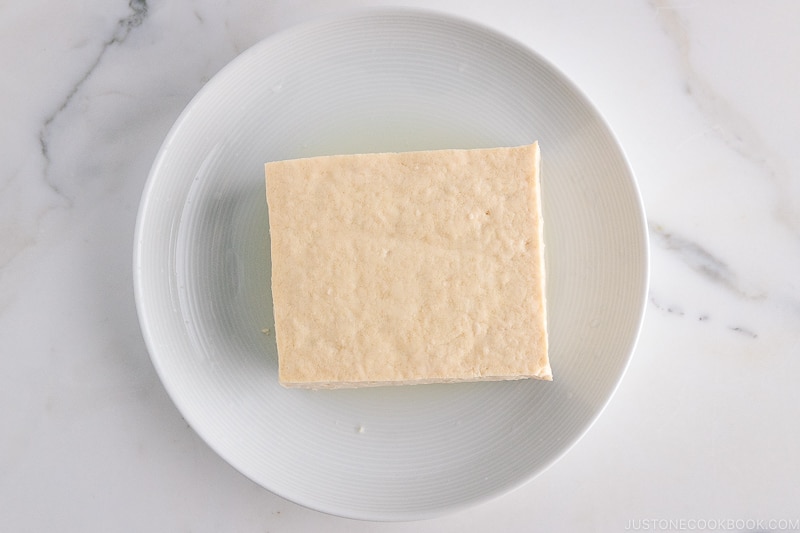
Momen means “cotton,” although the texture is not fluffy. The term “Momen” is derived from the cotton cloth traditionally used to press out water and does not refer to the texture. It is firm, dense, and has a coarse texture, and can hold its shape even when cooked. It is sold in square or rectangular blocks. It may be labeled as firm tofu outside of Japan.
How to use it: Add to braises and stir-fries such as Mapo Tofu and Goya Champuru (although the original Okinawan version uses an extra-firm tofu called Shima Tofu), cooked to make tofu pizza or teriyaki tofu, or dropped into hot pot dishes or soups. It can be eaten like Kinu tofu, but as the water is pressed out, it’s excellent for soaking up broths and has delicious flavors.
Yose Tofu/Sukui Tofu/Oboro Tofu/Zaru Tofu (寄せ豆腐・すくい豆腐・おぼろ豆腐・・ざる豆腐)
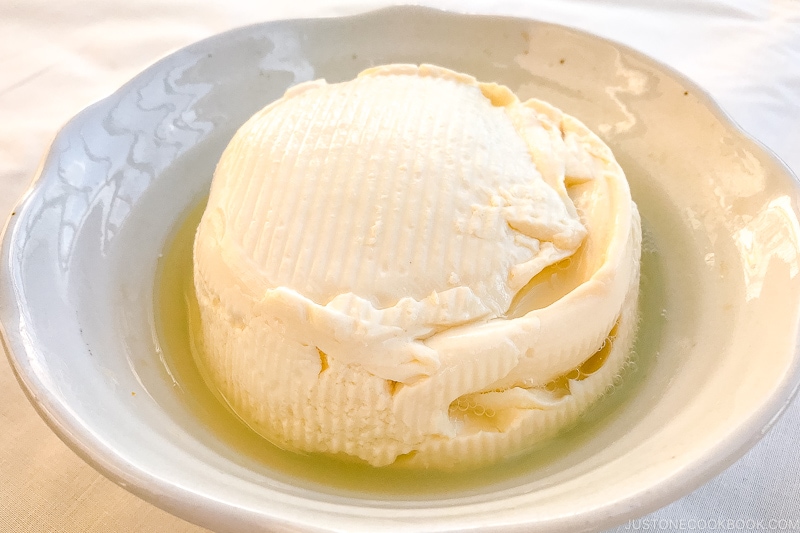
An extra soft, jiggly tofu made by mixing soy milk and nigari, it highlights the soybean flavor’s sweetness and richness. It has several names depending on its final shape and form.
Yose tofu (Yose (寄せ) means “gathered”) is made by scooping up and plopping the curds into round packages. Sukui tofu (Sukuu (掬う) means “to scoop up”) is tofu that’s scooped up and served as is.
Oboro tofu (Oboro (おぼろ) means “hazy, foggy, blurry,” usually referring to the moon) gets its name from the wobbly texture.
Zaru tofu (Zaru (ざる) is a bamboo strainer) is tofu drained over a bamboo filter, resulting in a slightly firmer tofu than the ones mentioned earlier. These types are tender and not soaked in water like Kinu and Momen tofu.

How to use it: Eat warmed or chilled, and treat it like Kinu tofu.
Jyuten/Juten Tofu (充填豆腐)
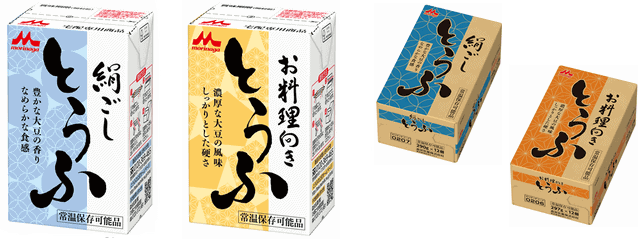
Jyuten (Juten) tofu is shelf-stable kinu tofu packaged without water. It’s made by the soybeans and nigari mixture seal packed and cooled in the container to harden. As it is pasteurized, some do not need refrigeration and have a long expiration date.
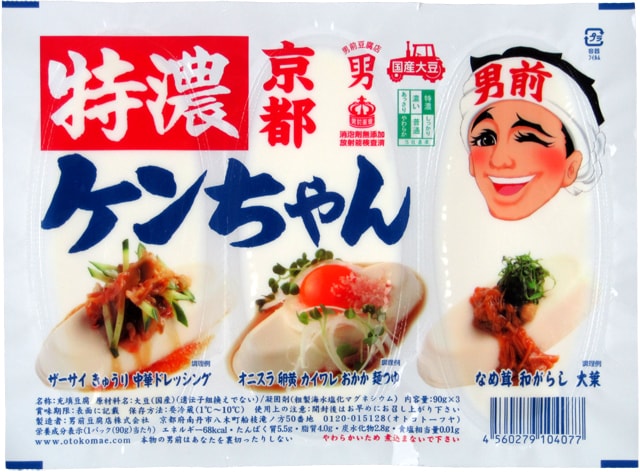
Some tofu sold in the refrigerated section at the supermarkets look like regular tofu, but they are Jyuten tofu. Check to see whether it’s vacuum-packed or packed in water.
How to use it: Eat warm or chilled, and treat it like Kinu tofu.

2. Processed Tofu
- Yaki Tofu/Yakidofu
- Nama Age Tofu/Atsuage
- Aburaage/Usuage
- Ganmodoki/Hiryozu
Yaki Tofu/Yakidofu (焼き豆腐)
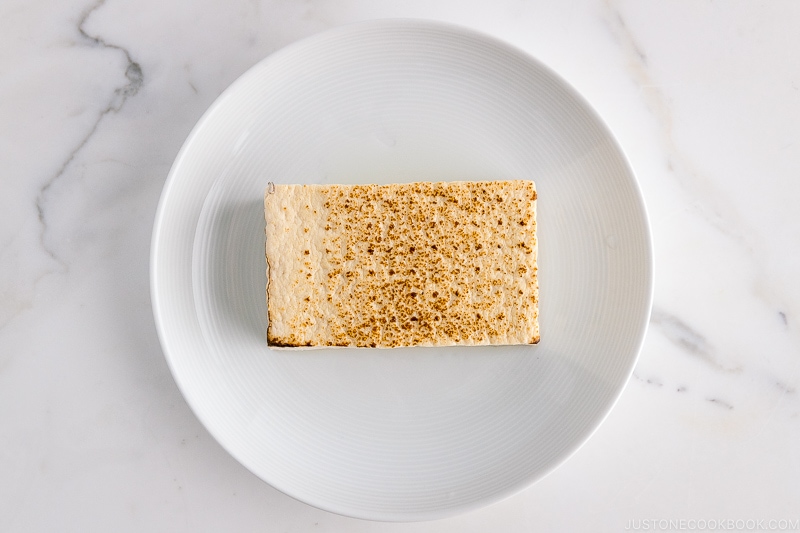
Yaki Tofu is grilled Momen tofu with charred grill marks, which are more for aesthetics.
How to use it: Add to hot pot, or cook like regular Momen tofu.
Nama Age Tofu/Atsuage (生揚げ豆腐・厚揚げ)
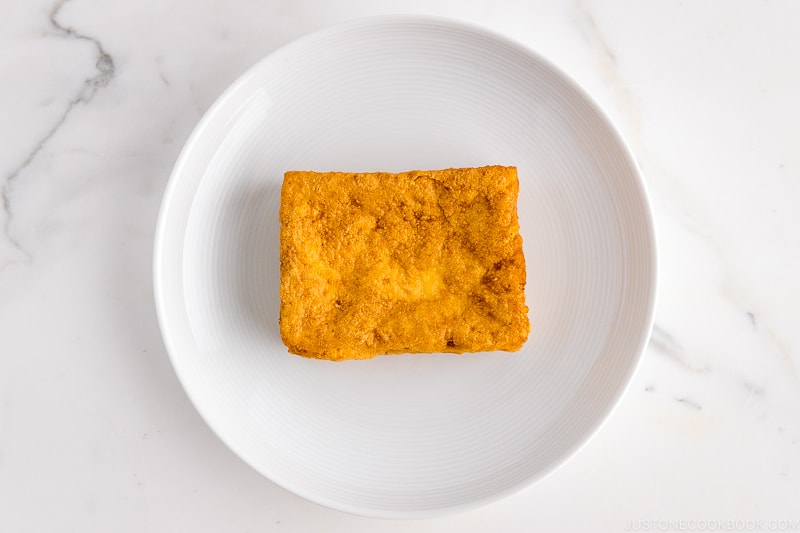
Both refer to fried Momen tofu with a golden brown exterior. It may be sold as blocks, cubes, or triangles. Kinu Age (絹揚げ) is a block of fried Kinu tofu.
How to use it: Toss into stir-fries, lightly toast with a drizzle of soy sauce, or add to oden.
Aburaage/Usuage (油揚げ・薄揚げ)
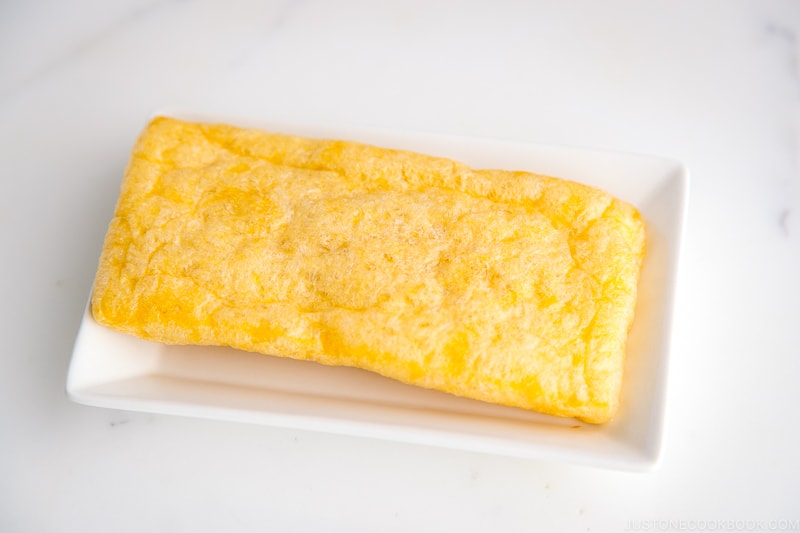
Made from thinly sliced Momen tofu, aburaage undergoes deep-frying twice. When served on top of udon or soba noodles, the dish is called Kitsune udon/Kitsune soba. When seasoned and stuffed with rice, it’s Inari sushi. It may be refrigerated, frozen, or canned (seasoned inari age).
How to use it: Make Kitsune udon/soba, Inari sushi, or slice and add to miso soup or stir-fries.
Ganmodoki/Hiryouzu/Hiryuzu (雁擬き・飛竜頭)
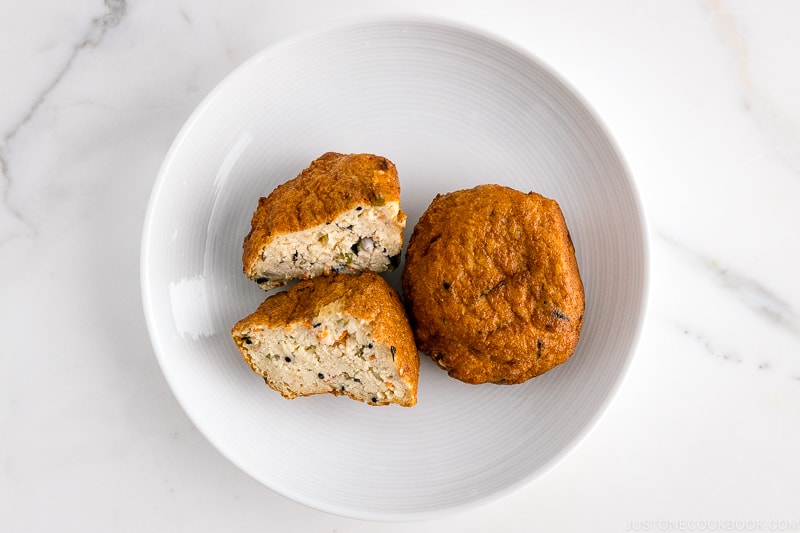
Ganmodoki/Ganmo are circular fritters made with Momen tofu and a binder, usually Yamaimo (Japanese mountain yam). It contains chopped vegetables such as shiitake mushrooms, carrots, lotus or burdock root, hijiki seaweed, or ginko nuts. There are two theories to the name; one is that it means “pseudo-duck” (gan (雁; duck), modoki (擬き; pseudo), as the taste was said to resemble duck meat, and the other is “pseudo-circle” (gan (丸; circle)) due to its shape. Ganmodoki is an important source of protein in Shojin Ryori. Ganmodoki is the Kanto term, Hiryouzu/Hiryuzu 飛竜頭 is the Kansai term.
How to use it: Steep in dashi and serve warm, add to braises or oden.

3. Tofu By-products
- Okara
- Yuba
- Koya Tofu/Kori Tofu
Okara (雪花菜)
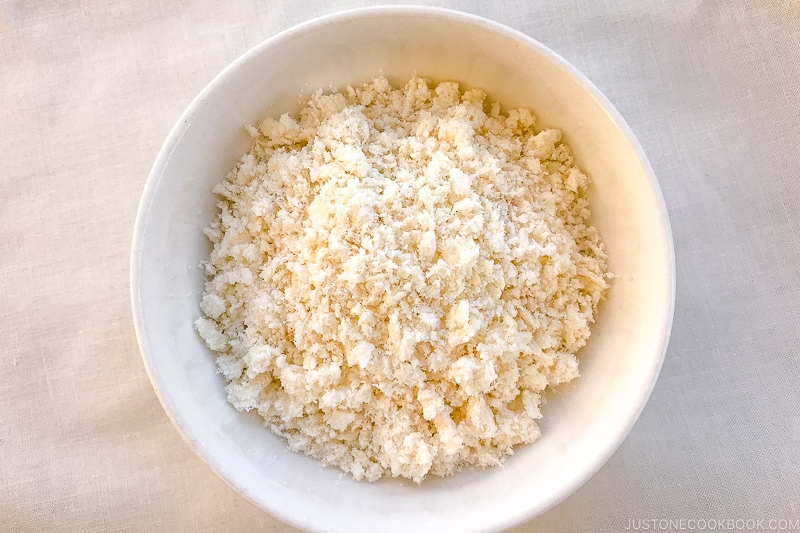
Okara is the discarded soybean pulp from making tofu and soy milk. With a super high water content, it is highly perishable but remarkably nutritious as it is high in dietary fiber. It has a gritty texture and is cooked in some form. As it is low in calories and highly fibrous (consequently fills you up), it is embraced by dieters.
How to use it: Cook it to make Unohana 卯の花, a savory dish of cooked okara with veggies, use as a filler in hambagu and korokke, or add it to baked goods and potato salads.
Yuba (湯葉)
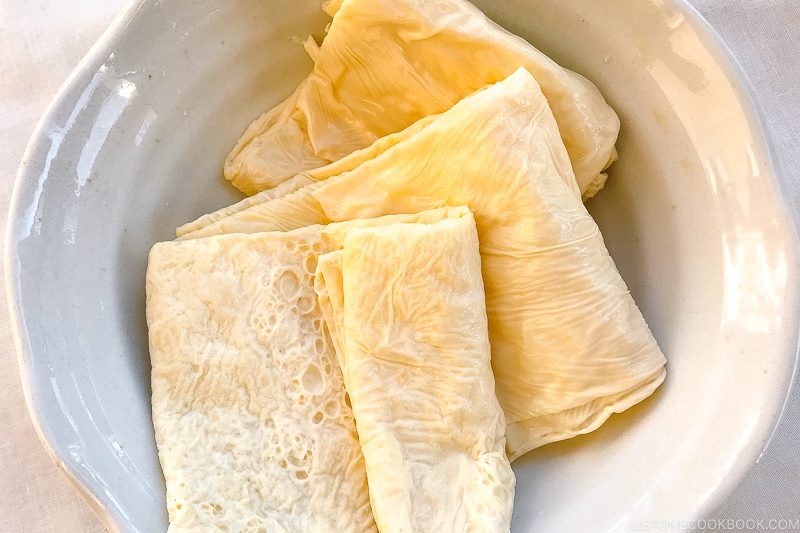
Also known as “tofu skin,” Yuba is made by boiling soy milk until ribbon layers form on top. Yuba is a specialty in Kyoto and other regions, where fresh Yuba is considered a delicacy. It can be found refrigerated or dried. Fresh Yuba is tender, whereas reconstituted dried Yuba has a rubbery texture.
How to use it: Add to soups or Nimono, or eat on its own like sashimi.
Koya Tofu/Kori Tofu (高野豆腐・凍り豆腐)
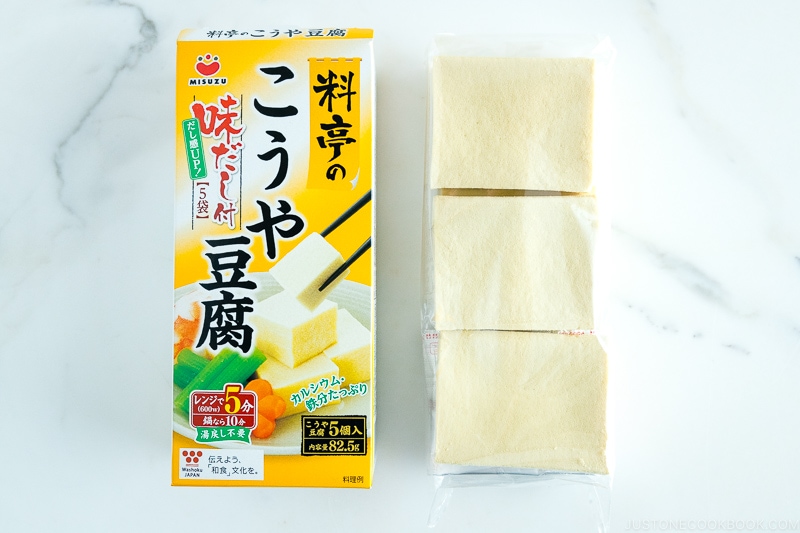
Found in the dried food aisle at the supermarket, Koya tofu (or Koyadofu) is freeze-dried, which undergoes aging. Koya (高野) refers to Mt. Koya in Wakayama prefecture, where it was supposedly first made by a Buddhist monk as part of Shojin Ryori. It is highly nutritious and a pantry staple, and the spongy texture is excellent for soaking up broths.
How to use it: Use in braises or nimono.

4. Flavored “Tofu”
- Tamago Tofu
- Goma Tofu
Tamago Tofu (玉子豆腐)
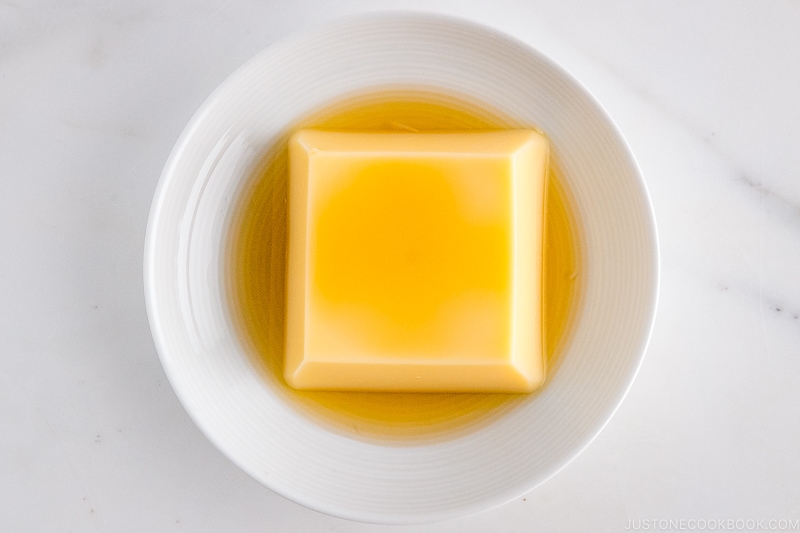
Tofu tamago is steamed eggs seasoned with dashi. It has no soybeans or nigari, but has the name “tofu” as the shape resembles tofu. It has a slightly eggy flavor and smooth texture, like custard.
How to use it: Eat warmed or chilled with seasoned dashi broth. Or top over rice like in the Netflix show “Midnight Diner: Tokyo Stories” (深夜食堂).
Goma Tofu (胡麻豆腐)
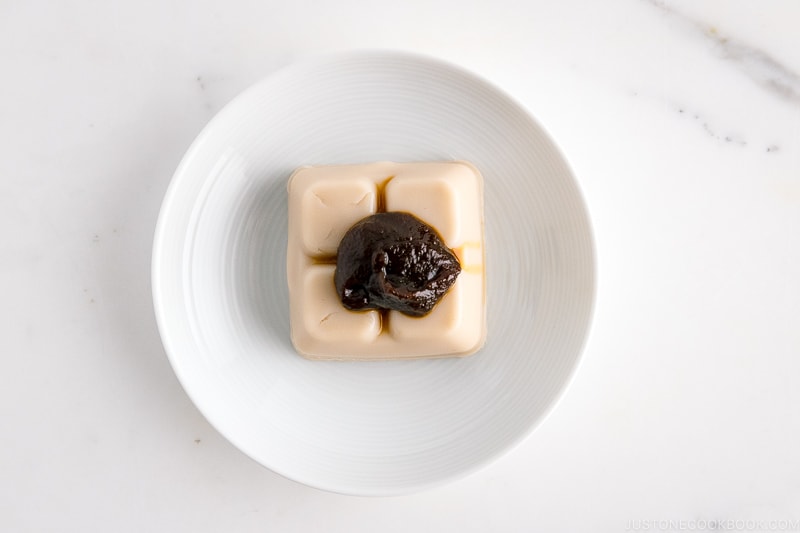
Goma tofu is a sesame paste coagulated with kudzu powder (a starch made of the kudzu plant). It is smooth in texture with slight nuttiness from the ground sesame.
How to use it: Eat warmed or chilled, top with a miso-based sauce or grated wasabi and soy sauce.

What is your favorite variety, and how do you like eating it? Or what turns you off? Please share your tofu episodes in the comment box below!










Greetings! My favorite hands down is Agedashi. Kombu dashi broth, grated daikon and a little green onion. Yum! Thank you for your recipes!
My latest curiosity is Yuba after enjoying it in the Trader Joe’s Thai Green Curry. However, when I purchased the frozen sheets, and thought/hoped they’d turn into silky ribbons like the TJ’s product, I found my homemade Thai curry’s yuba to have a texture similar to rubber bands. Bummer!
Do you have any recommendations for purchasing the silky yuba? And recipes for Using them?
Thank you so much for all of your beautifully written articles and amazing recipes!
Hi Kathey! If you’re in the US, check out hodo foods. More in this post: https://www.justonecookbook.com/yuba-tofu-skin/
Where I live in E. France I don’t find a lot of products in the supermarket but they always have tofu and smoked tofu in the organic section. For more I have to visit a specialist organic shop which has silken tofu and tempeh which is my favourite – and I think tempeh really is fermented tofu. I mostly use my tofu in stir-fries but change the coating (sometimes plain if it’s smoked, sometimes marinated, sometimes dipped in potato starch, egg and coated with panko. As a vegetarian, tofu is my go-to protein source a lot of the time. This article is very interesting and I always look at your recipes with tips for making something vegetarian or vegan – thank you!
Hi Gill! Thanks for reading and sharing about your tofu selection in your hometown! FYI, tempeh is made from cooked and fermented soybeans pressed into a cake, while tofu is made by curdling soy milk in a process similar to cheese making (so not fermented tofu).
Glad you enjoy cooking Nami’s recipes 🙂
Thank you for this informative article. The latter is a keeper. Oh, and you haven’t lived until you’ve eaten it deep fried. I now will start making all the tofu dishes you’ve covered.
Hi Bill! Thanks for reading! I agree, deep-fried tofu is the bomb. Hope you enjoy cooking the many tofu recipes on JOC 😀
Fascinating! Thank you for writing this.
Hello Susan, thank you for reading and for your kind words!
love your website. Very informative page on tofu. Can you post some recipes for Yuba?
thanks so much
Hi, thanks for reading! We’ll consider some yuba recipes in the future.
Great article! Please comment more on the degrees of firmness for tofu as it looks like that’s how it is sold in America (from soft to firm). Which is better for what?
Thanks for reading! We have a post on the variety of tofu and their culinary uses here. It’s a little difficult to say what is best for what as different brands are slightly different on the texture, and ultimately it comes down to personal preference. But hope this helps!
I love these food history lessons!!!
Hi Afton! Thanks for reading 🙂 Glad you’re enjoying the food history/culture posts. Please stay tuned for more!
I absolutely looove Agedashi tofu…yummm…I usually cook with firm tofu as I like the texture and it’s easy to cook with.
Hi Desiree! Thanks for reading! I agree, agedashi tofu is pretty versatile in cooking 🙂 Happy cooking!
Could we have recipes with yuba?
Have you tried Hodo Soy yuba? It’s so flavorful and delicious. I could eat it by itself, but I’m looking for recipes to mix things up.
Hi hmucha, thanks for the suggestion for more yuba recipes. I have passed it on to Nami.
I have not tried Hodo brand yuba as I’m based in Tokyo and it seems to be an Okland based food company. In Japan, we usually eat fresh yuba as is, with a trickle of soy sauce and wasabi. We don’t stir fry and cook with it much, not like in Chinese cuisine. But it seems like an interesting product. Thanks for sharing!
My all time favourite tofu was the tofu I used to buy fresh from the supermarket when I was living in Okinawa (shima dofu). It was delivered to the supermarket a few times a day and you would buy it still warm it was so fresh! I wish I could get tofu like it in Australia.
Hi Rachael! I hear fresh shima dofu is sublime. The shima dofu we can get in Tokyo is a few days old and not the best… Have you considered making shima dofu yourself?!
Hi Nami,
May I ask if you have carrot cake receipe?
I have been making your banana bread, soooo yummy. By the way, I reduced your 100g sugar to 75g. Perfect!!!
Hi Tina, this is Kayoko, author of this article.
To respond to your question, Nami does not have a carrot cake recipe. You can search for her recipes in the black search bar on the top right of the page. I’ve passed on your modifications to the banana bread recipe. Thanks for making it 🙂
Hello,
Your article/post about tofu is very interesting and it brought back some memories of our trips to Japan. Growing up in Hawaii, I’ve always eaten tofu and the different tofu products and like to cook tofu in so many different ways. But your article reminded me of our trips to Japan where I had the opportunity to discover fresh made and different types of toru: tofu made at Mt. Koya, goma tofu at a buffet restaurant, tofu in Okinawa, etc. All were different from what I was used to, but all were good. The BEST tofu is from various areas in Japan. Food wise, Japan NO KA OI.
Hi Dan, thank you for your comment! I hope you’ll be able to visit Japan soon to explore more tofu cuisines!
The selection for Japanese style tofu in Montréal is very limited. I have never been able to find Okara. My aunt, who is from the Ryu Kyu introduced me to this version of tofu many years ago. Is there a Chinese or Korean equivalent that I should look for? Many thanks.
Hi Ernst! Okara is very difficult to find if because it is VERY perishable. If you’re able to find a local shop that makes tofu, you could ask for it but it’s very rare that you’d find it at a Japanese/Asian supermarket. As for Ryukyu/Okinawan tofu, perhaps you’re looking for Shima tofu 島豆腐 (super firm tofu) or Yushi tofu ゆし豆腐 (super crumbly soft tofu like oboro tofu)? Depending on what you’re looking for, you may be able to substitute Shima tofu with firm tofu and Yushi tofu with super soft silken tofu. Good luck!
What is the best way to cook Kinu Tofu?
Hi Bob! As written in the article, kinu tofu crumbles very easily, so it’s best eaten as is instead of cooking with it. Sturdier tofu like momen tofu are better for cooking. Good luck!
This was super interesting story about tofu! I would like to know how to get some or all of them in USA as I only ever see a couple of them in grocery stores. Thanks a lot.
Hi Katherine, thank you for your comment! Unfortunately, many of these types may not be available outside of Japan, but have you checked your local Asian/Japanese/Chinese supermarkets? Or if there’s a local place that makes tofu? Good luck with your search!
Well written, helpful post! Thoroughly enjoyed it!! Adding the restaurant to my Want to Visit Google maps list for my next trip, and looking forward to trying a few of the recipes I wouldn’t have known to look for. Well done!
Hi Oxie, thank you for your kind words! There are many more tofu restaurants that I couldn’t fit into the article, but in Tokyo do check out Tofuya Ukai. It’s a beautiful Japanese restaurant specializing in tofu cuisine near Tokyo Tower. They make their tofu in house. There are many tofu restaurants in Kyoto as well!
Excellent, thanks so much, added that one too!